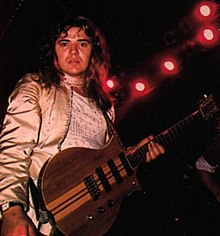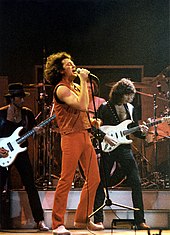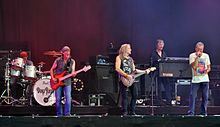Deep Purple
[4] Deep Purple, together with Led Zeppelin and Black Sabbath, have been referred to as the "unholy trinity of British hard rock and heavy metal in the early to mid-seventies".
In 2002, Lord retired and was replaced by Don Airey, which saw Deep Purple settle into its longest running line-up, unchanged for the next twenty years, until Morse announced his departure from the band in 2022.
Deep Purple (specifically Blackmore, Lord, Paice, Gillan, Glover, Coverdale, Evans, and Hughes) were inducted into the Rock and Roll Hall of Fame in 2016.
In 1967, former Searchers drummer Chris Curtis contacted London businessman Tony Edwards, in the hope he would manage a new group he was putting together, to be called Roundabout.
Impressed with the plan, Edwards agreed to finance the venture with his two business partners John Coletta and Ron Hire, who composed Hire-Edwards-Coletta Enterprises (HEC).
He was making a name for himself as a studio session guitarist, and had also been a member of the Outlaws, Screaming Lord Sutch, and Neil Christian, the latter artist prompting Blackmore's move to Germany.
Curtis's erratic behaviour and lifestyle, fuelled by his use of LSD, caused him to display a sudden lack of interest in the project he had started, forcing HEC to dismiss him from Roundabout.
[42] Gillan and Blackmore were less than happy at the band being tagged as "a group who played with orchestras", both feeling that the Concerto was a distraction that would get in the way of developing their desired hard-rocking style.
[45] The interplay between Blackmore's guitar and Lord's distorted organ, coupled with Gillan's powerful, wide-ranging vocals and the rhythm section of Glover and Paice, now started to take on a unique identity that separated the band from its earlier albums.
[47][48] In addition to increasing sales in the UK, the band were making a name for themselves as a live act, particularly with regard to the sheer volume of their shows and the improvisational skills of Blackmore and Lord.
[48] It included tracks that became live classics, such as "Highway Star", "Space Truckin'", "Lazy" and "Smoke on the Water", the last of which remains Deep Purple's most famous song.
Mark III embarked on a spring tour that included shows at Madison Square Garden, New York, on 13 March, and Nassau Coliseum four days later.
Hughes and Coverdale brought vocal harmonies and elements of funk and blues, respectively, to the band's music, a sound that was even more apparent on the late 1974 release Stormbringer.
Clem Clempson (Colosseum, Humble Pie), Zal Cleminson (The Sensational Alex Harvey Band), Mick Ronson (The Spiders From Mars) and Rory Gallagher were considered, and the final choice was American Tommy Bolin.
He had also played with Dr. John, Albert King, the Good Rats, Moxy and Alphonse Mouzon, and was busy working on his first solo album, Teaser, when he accepted the invitation to join Deep Purple.
[85] The break-up was finally made public in July 1976, with then-manager Rob Cooksey issuing a statement: "the band will not record or perform together as Deep Purple again".
The now-defunct Deep Purple began to gain a type of mystical status, with fan-driven reissues and newly assembled live and compilation albums being released throughout the late 1970s and early 1980s.
[94] The UK homecoming saw the band headline the 1985 Knebworth Fayre in June, where the weather was bad (torrential rain and 6 inches (15 cm) of mud) in front of 80,000 fans.
[96] Mark II followed Perfect Strangers with The House of Blue Light in 1987, which was supported by another world tour (interrupted after Blackmore broke a finger on stage while trying to catch his guitar after throwing it in the air).
[97][98] Eventually, after auditioning several high-profile candidates, including Brian Howe (White Spirit, Ted Nugent, Bad Company), Doug Pinnick (King's X), Australians Jimmy Barnes (Cold Chisel) and John Farnham (Little River Band), Terry Brock (Strangeways, Giant) and Norman "Kal" Swan (Tytan, Lion, Bad Moon Rising),[99] the band agreed on Joe Lynn Turner, who had previously been a member of Rainbow with Blackmore and Glover.
1993 would be Deep Purple's 25th anniversary year, with Lord, Paice and Glover (and the record company) wanting Gillan back for another Mark II reunion to celebrate this milestone.
Although Blackmore preferred Turner to remain in the group, he grudgingly relented, after requesting and eventually receiving $250,000 in his bank account[100] and Mark II completed the aptly titled The Battle Rages On... in 1993.
A live home video of the same name was also released, covering a show in Birmingham, England that displayed a very disgruntled Blackmore, who did not perform many of the guitar parts and at one point threw a cup of water at a cameraman for unknown reasons.
In 1999, Lord, with the help of a Dutch fan, who was also a musicologist and composer, Marco de Goeij, painstakingly recreated the Concerto for Group and Orchestra, the original score having been lost.
[156] Iron Maiden's bassist and primary songwriter, Steve Harris, states that his band's "heaviness" was inspired by "Black Sabbath and Deep Purple with a bit of Zeppelin thrown in.
[55] Queen guitarist Brian May referred to Ritchie Blackmore as "a trail blazer and technically incredible — unpredictable in every possible way...you never knew what you were gonna see when you went to see Purple".
[167] This tribute album included Iron Maiden, Metallica, Steve Vai, Carlos Santana, The Flaming Lips, Black Label Society, Papa Roach vocalist Jacoby Shaddix, Chickenfoot (former Van Halen members Sammy Hagar and Michael Anthony, guitarist Joe Satriani and Chad Smith of Red Hot Chili Peppers) and the supergroup Kings of Chaos (Def Leppard vocalist Joe Elliott, Steve Stevens, and former Guns N' Roses members Duff McKagan and Matt Sorum).
"[181] "With almost no exceptions, every hard rock band in the last 40 years, including mine, traces its lineage directly back to Black Sabbath, Led Zeppelin and Deep Purple.
[189] It was reported that Ian Gillan announced that he was barring Hughes, Coverdale, Evans and Blackmore from playing with them onstage, as these members are not in the current "living, breathing" version of the band.
Although barred from playing with Deep Purple, both David Coverdale and Glenn Hughes (as well as Roger Glover) joined fellow inductees Cheap Trick and an all-star cast to perform a cover of the Fats Domino song "Ain't That a Shame".

















